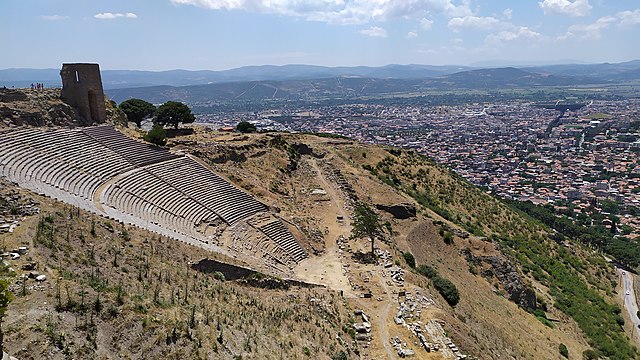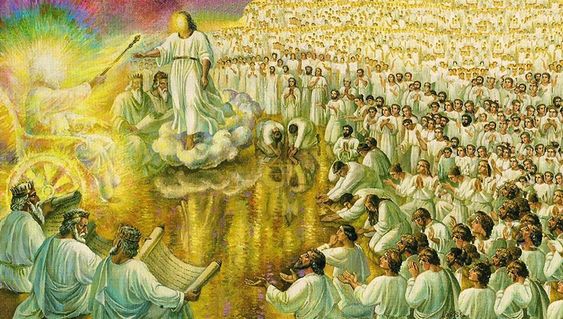Sermon for Evensong at St Michael & All Angels, Headingley, 21st April 2024. Text: Revelation 2:12-17
So, the Revelation to John, Chapter two. I suspect there are few preachers who whoop for joy when they find the text for the day is from this last book of the Bible, and I’m not one of them. It is notoriously difficult to understand, since it contains so much symbolism that made sense at the time of writing but is obscure to us two thousand years later. And, we don’t really do this kind of ‘apocalyptic’ writing these days. When people talk of the apocalypse, they are really thinking of some kind of dystopia, maybe the aftermath of a nuclear war or something.
But this revelation to John in his island retreat was meant to be an encouragement to him and the Christians he was writing to. The “seven letters to local churches” were intended for Christians facing persecution, to get them to look beyond their immediate troubles and find hope in their commitment to Jesus. Good advice I have received is not to focus in detail on what particular imagery might mean, but to try and understand the big picture of what Jesus was telling his church at that time.
Why does Jesus, through John, address church communities rather than individuals? Because the strength of Christianity lies in the local church, whether in worship, witness or action. Alone, we can do little; together, we can achieve much. Also, because in times of difficulty, there is an increased need to gather together for security and mutual encouragement. We see that right from the start of the Church, in the upper room on Easter evening, the disciples gathered “with doors locked for fear of the Jews”.
Each local Christian community – each parish or even congregation within a parish – will have its own feel, its own local traditions, and its own difficulties. As someone who has always appreciated the breadth of traditions within the Church of England, it’s lovely to be part of two very different services in one day. We had our usual Common Worship communion this morning at my local church in Bramley, where we have a very diverse congregation but in particular lots of young families from different cultural and ethnic backgrounds. The mainly contemporary worship songs were led by an older couple on guitar and flute, and a younger couple singing. Quite a contrast to this more traditional language service with choir and organ, but I find spiritual encouragement in both. In John’s day, I expect it was no different.
Each of these local Christian communities in second-century Asia Minor, then, receives a particular message from Jesus, which in each case both praises and criticises them, before offering a promise for those who stay faithful in the face of persecution. The praises, the criticisms, and the promises are specific to each place, because Jesus always knows that each church community faces particular challenges and has particular strengths.

Today’s reading is to the Christians of Pergamos – modern day Bergama, a city fifteen miles inland on the Asian side of Turkey. They are praised for holding fast to their faith, even when at least one of them has been killed for it. In the other letters, congregations are praised for their hard work, perseverance, keeping Christ’s word and not denying his name. The emphasis is not about becoming martyrs but being true to the Christian worldview when the world is going in other directions. In our own time, it is increasingly hard to stand up for tolerance, truth and neighbourly love when society is becoming more divided, and false news and lies are all around us.
On the other hand, they are criticised for two things. Firstly for holding to the teaching of Balaam. This refers to the Old Testament book of Numbers, where the prophet Balaam, despite being told by God to bless the people of Israel, also encouraged them to sin in ways that we would still find unacceptable today. And for holding the teaching of the Nicolaitans – we’re not quite sure who they were, but from the context they were doing the same in their day, following the religious and sexual practices of the people around them rather than being distinctive in following Christian ethics.
So the overall message to the church in Pergamos seems to be: keep your faith, even when times are difficult, and be careful not to let the ways of the world compromise the way you practice your faith.
What, I wonder, would Jesus say to the church in Headingley? I believe he praises you for holding together as a benefice of three quite different churches, each responding to the needs of the age in a different way. St Chad’s is taking a lead on environmental issues, its rewilded churchyard and solar panels an example to other churches across the Diocese of how we might respond to the environmental crisis. Heston at All Hallows has developed a distinctive ministry inclusive of people with all kinds of physical, financial and spiritual needs, and engaging with those of other faiths to find common ground in serving the needs of the parish.
Here at St Michael’s he praises you for engaging in the cultural and civic life of Headingley, showing a commitment to being inclusive, and worshipping him in words and music that seek to express the spiritual life within us, whether in contemporary or traditional style.
But for what would he criticise you? To quote the words of the confession that we said earlier, what have you as a community, left undone that you ought to have done, or done that you ought not to have done? I do not live among you, and it’s not for me to judge you. But I leave you to ponder that.
The praises, in any event, are more important than the criticisms. As the Psalmist said, “God’s anger lasts only a moment, but his favour lasts a lifetime”. So at the end of each of the letters is a promise. The promises are expressed symbolically and addressed this time to individuals rather than congregations. The Christians in Pergamos are promised the ‘hidden manna’, probably the reason this reading is paired with the one from Exodus. The manna, the miraculous bread from heaven, has always been understood by the Church to be not only a sign of God’s provision to those in need, but also a foretaste of the eternal life that comes through Jesus to those who believe in him: Jesus who called himself the ‘bread of life’.
The other promise is of a white stone with a secret name. What that means is less obvious, but it may be a way of saying that we need to treasure our deepest faith, our most intimate understanding of God, in the secrecy of our own heart. That way, whatever life may throw at us, our faith in Christ is kept secure.
Other symbolic promises in this set of letters include “eating from the tree of life”, “not being hurt by the second death”, “the right to sit with Jesus on his throne”, “being dressed in white”; and being given “authority over the nations”. One of the threads running through the New Testament is that our rewards for living faithfully in this life will be given us in the next. It is of course impossible to really know what such existence will be like, but the Revelation reminds us to look beyond the troubles of this life and stick with Jesus along the way.
So if I can sum up what we can learn from this small part of the last book of the Bible, it is this: that as part of the churches in Headingley, as well as the wider Church of England and indeed the Church of Christ throughout the world, we must recognise the tension between engaging with the world and retaining our distinctiveness as Christians. We can celebrate the diversity within and between our congregations, while seeking to find the specific ministry that each local church has to its parish. And that while there will no doubt be aspects of our church life that could be criticised, much more important is to hear the words of Jesus praising us for when we get it right, for by holding to our faith in him and seeking to respond to his call, we know we shall inherit that eternal life that only He can give.

